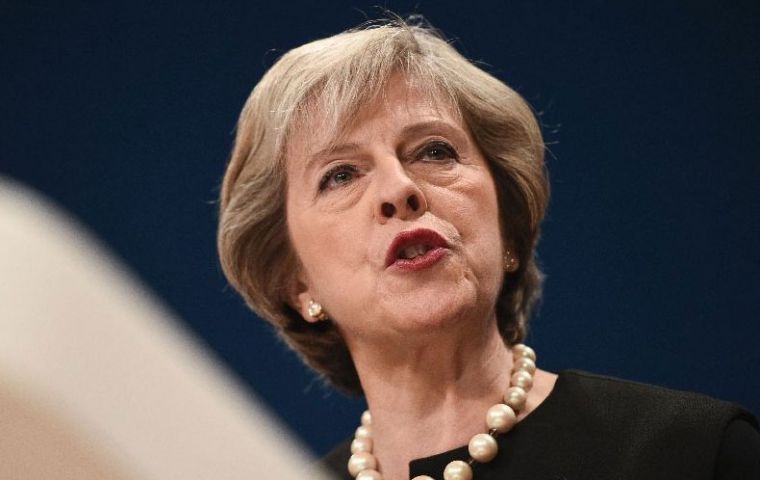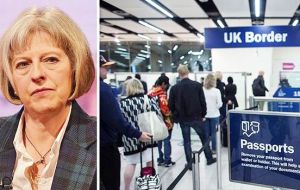MercoPress. South Atlantic News Agency
PM May announces Brexit process should be over by 2019 with strong limits on immigration policy
 May’s comments, first to BBC, later in the opening of the Conservative Party’s conference were the most specific to date on her plans for Britain’s post-EU future.
May’s comments, first to BBC, later in the opening of the Conservative Party’s conference were the most specific to date on her plans for Britain’s post-EU future.  May left no doubt Sunday that she will not accept that free-movement principle, saying that voters had made clear that they want reduced immigration.
May left no doubt Sunday that she will not accept that free-movement principle, saying that voters had made clear that they want reduced immigration. Prime Minister Theresa May said on Sunday that Britain would begin the process of withdrawing from the European Union by the end of March and suggested that she would seek a clean break that makes limits on immigration a priority.
The announcement eased the anxieties of Brexit backers, who had feared that May might delay the start of Britain’s withdrawal by a year or more and that she would seek only modest changes in her country’s relationship with the 27 remaining members of the bloc.
May’s comments — first to the BBC in a Sunday morning interview and later in the opening speech of the Conservative Party’s annual conference — were the most specific she has given to date on her plans for Britain’s post-EU future.
The country voted in June to leave the bloc, 52% to 48%. Previously she had said only that the country would not trigger Article 50, the never-before-used mechanism for an EU exit, this year.
The early 2017 timetable is roughly in line with what European leaders who have met with May have said they expected. But some British advocates for sticking with the E.U. had suggested that the process should be put on hold until after France and Germany — the two most important European voices in the negotiations to come — have held national elections slated for next year.
May on Sunday firmly rejected those calls, a decision that was praised by EU leaders, who are pressing Britain to get on with its departure. European Council President Donald Tusk tweeted that May’s words had brought “welcome clarity.”
Even after Britain triggers Article 50, it will remain an EU member for some time. The rules call for a two-year negotiation on the withdrawal terms, although that time limit could be extended if all sides agree.
If Britain does leave two years after triggering Article 50, a departure in March/April 2019 could allow May to claim victory on her oft-repeated pledge that “Brexit means Brexit” with a year to go before scheduled national elections.
May again refrained on Sunday from saying exactly what she will ask for in her negotiations with Europe, insisting that she won’t give “a running commentary” on British bargaining.
She also rejected the idea that Britain must choose between “hard Brexit” and “soft Brexit,” saying it’s a “false dichotomy” to suggest that Britain must decide between “some form of continued E.U. membership and . . . a conscious decision to reject trade with Europe.”
May left no doubt Sunday that she will not accept that free-movement principle, saying that voters had made clear that they want reduced immigration. She was far less resolute in defending Britain’s single-market membership, and she specifically ruled out a Norwegian-style arrangement that grants trade benefits in exchange for acceptance of the free movement of workers.
“The process we are about to begin is not about negotiating all of our sovereignty away again,” she said. “It is not going to be about any of those matters over which the country has just voted to regain control. It is not, therefore, a negotiation to establish a relationship anything like the one we have had for the last 40 years or more.”




Top Comments
Disclaimer & comment rules-

-

-

Read all commentsAbout time but now she has to DO what she says.
Oct 03rd, 2016 - 10:41 am 0And fight of the remoaners on the way,
Oct 03rd, 2016 - 01:01 pm 0but it will still take another two years,
providing were all still alive to enjoy it.
Take note Toby, no free movement of people, or paying into EU budgets.
Oct 03rd, 2016 - 06:58 pm 0We shall see what sort of a trade deal may be possible, Spanish veto’s notwithstanding.
Remembering that under WTO base rules of 3% tariff both ways, we will do very well out of it, mostly at the expense of the French and Germans.
Commenting for this story is now closed.
If you have a Facebook account, become a fan and comment on our Facebook Page!